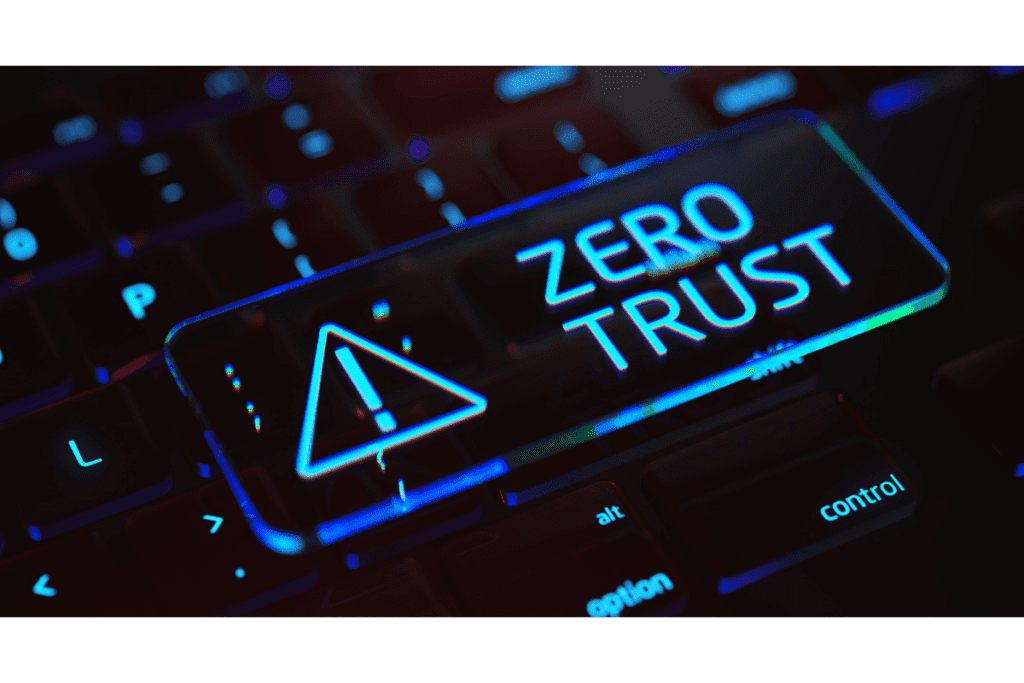Project Plan Essentials for Zero Trust Adoption: How to Implement Zero Trust Architecture to Future Proof Your Organization
The implementation of Zero Trust architecture is a crucial step for organizations looking to enhance their cybersecurity. By adopting the principles of Zero Trust and following a well-defined project plan, businesses can create a more secure network environment and protect their critical assets from potential threats. This article focuses on how you can include the Project Plan Essentials for Zero Trust Adoption.
According to the NIST Special Publication 800-207, the Zero Trust term is more of a mindset shift in cybersecurity to move defenses from a network perimeter (i.e., firewall) stance, to one around the users and or assets/resources of the organization. Basically, shifting cybersecurity to a framework that assumes a firewall breach and secure the corporate assents/user accounts accordingly.
What is an Overview of the Zero Trust Architecture?
Understanding the principles of the Zero Trust model
Zero Trust is a security model that requires organizations to never trust or assume the safety of any user, device, or workload, whether they are inside or outside the network perimeter. The Zero Trust model focuses on authenticating and authorizing every user and device before granting access to resources, regardless of their location. The 12 Principles are further expanded below.
Overview of the Zero Trust architecture
Zero Trust architecture is a comprehensive approach to network security that emphasizes the importance of continuous monitoring, visibility, and granular access control. It involves implementing multiple layers of security controls to protect critical assets and prevent unauthorized access.
How Zero Trust enhances cybersecurity
Zero Trust enhances cybersecurity by shifting the traditional perimeter-centric security approach to a more data-centric approach. It provides better visibility into user and device behavior, detects anomalies, and enables organizations to respond quickly to potential security threats. By adopting Zero Trust, organizations can better protect their data and reduce the risk of data breaches.
Why is the Zero Trust Model important?
The need for Zero Trust in today’s security landscape
In today’s evolving threat landscape, traditional security measures are no longer sufficient to protect organizations against advanced and persistent cyber threats. Zero Trust provides a proactive approach to security by assuming that the network is already compromised and requires continuous authentication and authorization to ensure the security of critical assets.
Benefits of implementing a Zero Trust network
Implementing a Zero Trust network brings several benefits to organizations. It improves the overall security posture by reducing the attack surface and minimizing the impact of potential breaches. Zero Trust also provides businesses with better visibility and control over their network traffic, enhancing their ability to detect and respond to security incidents effectively.
How Zero Trust improves security posture
Zero Trust improves security posture by implementing essential security controls, including least privilege access, multi-factor authentication, and encryption. By adopting these controls, organizations can significantly reduce the risk of unauthorized access and data breaches. Zero Trust also provides better visibility into network traffic, allowing organizations to identify and address potential vulnerabilities more effectively.
What are the NIST 12 Principles of the Zero Trust Security Model?
The National Institute of Standards and Technology (NIST) has outlined principles and guidelines for implementing a Zero Trust Architecture (ZTA) in their special publication NIST SP 800-207. The Zero Trust Security Model is based on the concept that no user or system should be trusted by default, even if they are inside the organization’s network. Here are the core principles of the Zero Trust Security Model as defined by NIST:
- Never Trust, Always Verify: Do not inherently trust any user or system, regardless of whether they are inside or outside the network perimeter. Always authenticate and authorize before granting access.
- Least Privilege Access: Grant users and systems the minimum levels of access — or permissions — needed to accomplish their tasks.
- Micro-Segmentation: Divide the network into smaller, isolated segments to limit unauthorized access and potential lateral movement within the network.
- User and Entity Behavior Analytics (UEBA): Continuously monitor and analyze the behavior of users and entities and respond to anomalous activities in real-time.
- Multi-Factor Authentication (MFA): Require multiple forms of authentication before granting access.
- Continuous Monitoring: Continuously monitor the network and adapt as technology and organizational needs change. This includes assessing the security state of resources.
- Secure Communication: Ensure that all communications are encrypted and secure, both internally and externally.
- Architecture-Centric: Focus on the overall architecture, not just individual technologies, to ensure that all components work together to provide robust security.
- Use of Threat Intelligence: Utilize up-to-date threat intelligence to understand the current threat landscape and adapt security measures accordingly.
- Focus on Asset: Understand and focus on protecting the organization’s key assets, not just building a perimeter around the entire network.
- Integration with Existing Security Practices: Zero Trust should be integrated with existing security practices, tools, and architectures to enhance overall security without unnecessary duplication.
- Adaptive Policies: Implement adaptive security policies that can change based on context, risk, and other dynamic factors.
These principles guide the design and implementation of a Zero Trust Architecture, shifting the focus from merely defending the network perimeter to protecting the organization’s data, assets, applications, and services, regardless of where they are located or accessed.
Are there 5 or 7 Pillars in Zero Trust?
Some organizations and frameworks describe Zero Trust using a set of 5 or 7 foundational pillars or principles. In the context of NIST’s approach to Zero Trust, they don’t specifically define a set number of “pillars” in their Zero Trust Architecture (ZTA) guidelines (NIST SP 800-207).
The concept of Zero Trust can be described through various frameworks, and different organizations might define a different number of pillars or principles.
It’s important to note that these pillars can vary depending on the specific framework or interpretation of Zero Trust being used. Always refer to the specific guidelines or standards being followed within your organization or industry.
Here’s a general breakdown:
5 Pillars of Zero Trust (commonly referenced):
- Identify and Classify
- Multi-Factor Authentication (MFA)
- Least Privilege Access
- Micro-Segmentation
- Continuous Monitoring
7 Pillars of Zero Trust (as defined by some frameworks):
- Data
- People
- Workloads
- Devices
- Networks
- Automation & Orchestration
- Visibility & Analytics
Why Should You Invest in a Roadmap for Your Zero Trust Journey?
An investment in a Zero Trust Roadmap is critical to your organizations overall success. This transformation can be very disruptive if it is not planned out and executed correctly. Zero Trust requires a shift in the way organizations think about security, and a roadmap can help ensure a smooth transition.
A Roadmap helps provide a clear direction, enables prioritization, aligns stakeholders, facilitates resource planning, manages risks, and supports scalability and adaptability. Without a roadmap, organizations may face challenges, inefficiencies, and potential security gaps.
6 reasons Why Investing in a Roadmap for Your Zero Trust journey is Important
1. Clear direction: A roadmap helps provide a clear and structured path for implementing Zero Trust. It outlines the steps, milestones, and timelines needed to achieve your security goals. Without a roadmap, organizations may struggle with inconsistent or unclear implementation, leading to a lack of progress or increased security risks.
2. Prioritization: A roadmap helps prioritize the implementation of Zero Trust measures based on the organization’s needs and resources. It allows you to identify the most critical areas to focus on first, ensuring that the highest-risk assets are protected early on. Without a roadmap, organizations may waste time and effort on less critical areas, leaving vital systems exposed.
3. Stakeholder alignment: Zero Trust implementation involves multiple stakeholders, including IT security teams, executives, and end-users. A roadmap helps in aligning these stakeholders by providing a shared understanding of the goals and objectives of the Zero Trust journey. It allows for effective communication, collaboration, and buy-in from all parties involved.
4. Resource planning: Implementing Zero Trust requires substantial resources, including financial, technological, and human capital. A roadmap helps in effectively planning and allocating these resources. It allows organizations to budget for necessary investments, hire or train personnel, and identify any potential gaps or limitations. Without a roadmap, organizations may experience resource constraints or overinvest in unnecessary areas.
5. Risk management: Zero Trust aims to mitigate security risks by assuming that no user or device is inherently trustworthy. A roadmap helps identify and manage these risks by outlining specific security measures and controls at different stages of the implementation process. It ensures a methodical and systematic approach to risk reduction, minimizing the chances of overlooking critical vulnerabilities.
6. Scalability and adaptability: Zero Trust is an ongoing process that requires continuous evaluation, adjustment, and improvement. A roadmap provides a framework for scaling and adapting the Zero Trust strategy as the organization evolves. It allows organizations to measure progress, evaluate outcomes, and make informed decisions about future investments and adjustments.
How to implement Zero Trust Architecture?
Step-by-step guide to implementing a Zero Trust model
Implementing a Zero Trust model requires a well-defined project plan. The first step is to assess the current security infrastructure and identify any gaps or vulnerabilities. Next, organizations should define their Zero Trust objectives and develop a roadmap for implementation. This includes establishing security controls, authentication mechanisms, and access policies.
Essential security controls for implementing Zero Trust
Key security controls for implementing Zero Trust include granular access controls, network segmentation, and continuous monitoring. These controls ensure that only authorized users and devices have access to specific resources and data. Implementing encryption and strong authentication mechanisms further enhances the security of the network.
Integrating Zero Trust with existing security infrastructure
Organizations can integrate Zero Trust with their existing security infrastructure by leveraging technologies such as identity and access management (IAM), security information and event management (SIEM), and endpoint protection solutions. Integrating these tools allows for better visibility, monitoring, and management of the Zero Trust environment.
What are some key considerations for Zero Trust adoption?
Preparing for change management during Zero Trust implementation
Transitioning to a Zero Trust model requires careful change management to ensure a smooth adoption process. This includes educating employees about the benefits of Zero Trust, providing training on new authentication mechanisms, and aligning organizational policies with the Zero Trust principles.
Developing a communication plan to drive user adoption
Effective communication is crucial for successful Zero Trust adoption. Organizations should develop a communication plan that highlights the benefits of Zero Trust, addresses any concerns or resistance, and provides clear instructions on how users can adapt to the new security measures. This helps in driving user adoption and minimizing the impact of the transition.
Understanding that a successful adoption of Zero Trust Security will require significant focus on users. Even though it is a technical architecture to secure internal applications and sensitive data, the Zero Trust Maturity model centers around people.
Analyzing and addressing challenges in Zero Trust implementation
Implementing Zero Trust may come with its own set of challenges, such as compatibility issues with legacy systems, complexity in managing multiple security controls, and resistance to change. Organizations need to conduct a thorough analysis of these challenges and develop strategies to address them effectively.
What are some Project Plan Essentials for Zero Trust Adoption?
The A3 strategy can help with Zero Trust adoption and implementation
The A3 strategy, named after the three key components – Assess, Adapt, and Automate, can help organizations in their Zero Trust adoption journey. Assess involves assessing the existing security infrastructure and identifying areas for improvement. Adapt focuses on adapting existing policies and practices to align with Zero Trust principles. Finally, Automate involves automating security controls and processes to ensure continuous monitoring and enforcement of Zero Trust policies.
Ways to plan and execute a successful Zero Trust rollout
A successful Zero Trust rollout requires careful planning and execution. Organizations should start with a pilot project to test the feasibility and effectiveness of Zero Trust in their environment. This allows for fine-tuning of security controls and identification of potential challenges before a full-scale implementation. Regular assessments and audits should be conducted to ensure ongoing compliance with Zero Trust principles.
The importance of stakeholder engagement in Zero Trust projects
Stakeholder engagement is critical for the success of Zero Trust projects. It is important to involve key stakeholders from different departments, including IT, security, and business units, in the decision-making process. Their input and collaboration help in ensuring that the Zero Trust implementation aligns with the organization’s goals and addresses specific security needs.
 What Should You Include In Your Zero Trust Implementation Project Plan Checklist?
What Should You Include In Your Zero Trust Implementation Project Plan Checklist?
Many organizations may think this is an Information Security or Information Technology project. However, Zero Trust in an enterprise endeavor. In order to have a successful rollout, an organization must have a comprehensive plan.
This checklist takes into account the Discovery items to make sure the organization is prepared to take on this change. It also discusses the key plan items and change management needed to facilitate communication throughout all phases of the rollout.
By considering these checklist items, an organization can ensure a well-planned and successful implementation of Zero Trust, enabling enhanced security and protection against evolving cybersecurity threats.
1. Executive sponsorship:
Ensure that there is buy-in from senior executives who can provide the necessary resources and support for the implementation.
2. Stakeholder identification:
Identify all relevant stakeholders, such as IT teams, security teams, business units, and external vendors, who will be impacted by the implementation.
3. Current state assessment:
Evaluate the organization’s existing cybersecurity posture, infrastructure, and network architecture to identify any gaps or vulnerabilities.
4. Risk assessment:
Conduct a thorough risk assessment to identify potential risks and vulnerabilities that Zero Trust can help mitigate.
5. Goal definition:
Clearly define the organization’s goals and objectives for implementing Zero Trust, such as improving security, reducing the risk of data breaches, or enhancing user experience.
6. Scope definition:
Determine the scope of the implementation, including which systems, applications, and user groups will be included in the Zero Trust architecture.
7. Technology evaluation:
Evaluate various technology solutions available in the market to identify the most suitable tools and platforms for implementing Zero Trust.
8. Vendor selection:
Select vendors or technology partners who can provide the required solutions and support for the Zero Trust implementation.
9. Architecture design:
Develop a detailed architecture design that outlines the various components, such as identity and access management, multi-factor authentication, micro-segmentation, and encryption, that will be implemented as part of Zero Trust.
10. Policies and procedures:
Define and document the policies, procedures, and guidelines that will govern the implementation and ongoing management of Zero Trust.
11. Training and education:
Develop a training and education plan to ensure that all relevant stakeholders and end-users are aware of the concept and benefits of Zero Trust and understand their roles and responsibilities.
12. Pilot testing:
Conduct pilot testing with a small group of users or systems to validate the effectiveness and efficiency of the Zero Trust implementation.
13. Rollout plan:
Develop a phased rollout plan that outlines the sequence and timeline for implementing Zero Trust across the organization, considering any dependencies or constraints.
14. Communication plan:
Develop a comprehensive communication plan that includes regular updates, newsletters, town hall meetings, and other initiatives to keep all stakeholders informed about the progress, benefits, and impact of the Zero Trust implementation.
15. Change management:
Implement a change management strategy to address any resistance or challenges that may arise during the implementation, including providing support, training, and addressing concerns.
16. Monitoring and analytics:
Establish mechanisms for continuous monitoring, analysis, and reporting of the effectiveness and performance of the Zero Trust implementation, including key metrics and indicators.
17. Ongoing maintenance and updates:
Develop a plan for ongoing maintenance, updates, and enhancements to the Zero Trust architecture to ensure its effectiveness and alignment with changing business and technology requirements.
18. Evaluation and improvement:
Establish a process for periodically evaluating the effectiveness and efficiency of the Zero Trust implementation and identifying areas for improvement.
 FAQs
FAQs
Q: What is Zero Trust Architecture?
Zero Trust Architecture is a security model that requires strict identity verification and authentication for every user and device trying to access resources within a network, regardless of whether they are inside or outside the network perimeter.
Q: What are the key principles of Zero Trust Architecture?
The key principles of Zero Trust Architecture include never trusting and always verifying, assuming all traffic is potentially malicious, and continuously monitoring and analyzing network activity for anomalies.
Q: What is Zero Trust Network Access?
Zero Trust Network Access (ZTNA) is a type of secure network access that follows the principles of Zero Trust Architecture by verifying user identities and devices before granting access to applications and resources.
Q: How does Zero Trust help in improving cybersecurity?
Zero Trust helps in improving cybersecurity by implementing strong identity verification, continuous monitoring, and limiting access privileges. It reduces the risk of unauthorized access and data breaches.
Q: What are the essentials for adopting Zero Trust?
The essentials for adopting Zero Trust include establishing a clear project plan, conducting a comprehensive assessment of the current network infrastructure, implementing strong authentication and access controls, and continuously monitoring network activity.
Q: How can organizations implement Zero Trust successfully?
Organizations can implement Zero Trust successfully by following a phased approach, conducting thorough planning and risk assessments, involving key stakeholders, and leveraging zero trust solutions and technologies.
Q: What is the overview of Zero Trust?
Zero Trust is a security approach that assumes no entity, whether inside or outside the network, should be trusted by default. It requires verifying every user and device before granting access to resources.
Q: What are the benefits of Zero Trust Architecture?
The benefits of Zero Trust Architecture include improved security posture, reduced risk of data breaches, increased visibility and control over network activities, and enhanced protection against insider threats.
Q: What is Frictionless Zero Trust?
Frictionless Zero Trust refers to the implementation of Zero Trust Architecture in a way that minimizes user disruptions and maintains a seamless user experience while still ensuring strong security controls.
Q: How can organizations transition to Zero Trust?
Organizations can transition to Zero Trust by gradually implementing zero trust principles and technologies, conducting proper planning and risk assessments, and gradually phasing out legacy network security models.
Conclusion
Zero Trust is not a project with an end date, but a continuous improvement mindset and approach to security. It requires ongoing evaluation, monitoring, and updates to ensure that the organization’s security measures are aligned with current threats and risks.
Implementing Zero Trust is an ongoing process that involves collaboration and communication between stakeholders, regular training and education for employees, and the utilization of advanced technologies and tools.
Organizations must constantly review and adapt their security policies and controls to address emerging threats, incorporate new technologies, and stay ahead of attackers.
By adopting a continuous improvement mindset, organizations can better protect their critical assets and data and mitigate the risks of cyberattacks.
If you liked this article, remember to subscribe to MiamiCloud.com. Connect. Learn. Innovate.








